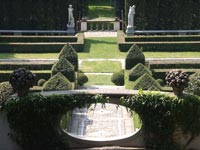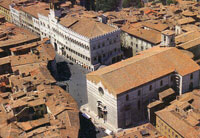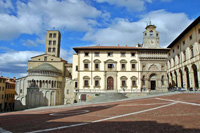|
The painting of Piero della Francesca (1416 ca. – 1492) stands out as a noble effigy amongst the prestigious artistic testimonials guarded within the towns of the valley,. An artist who has left in his native Borgo Sansepolcro and the neighbouring Monterchi indelible evidence of his fervid work. The vast and prosperous plain of the river Tiber, crowned by mountains and gentle sloping hills and washed by the silver waters of the Tiber river are depicted in the landscapes he painted which form an important part of the legacy of 14th century Italian painting. The history of this artistic genius who up to the 19th century was more famous as a scientist, master of prospective and author of De Prospectiva Pingendi, starts in this region which had sheltered artists of various origins and cultures so that a vivacious climate of experiences, ideas and directions was generated which is reflected in a good part of the works which can still be seen in the area.
During the years when anonymous and unknown painters accepted important commissions in the valley, Piero della Francesca was signing the contract for the painting of the polyptych of the Misericordia (1445), a work destined for the church of the same name and which was transferred in 1901 to the local museum. The artist who had already assumed his humanistic traits after his Florentine experience of 1439 with Domenico Veneziano, fully developed the illumination possibilities of a gold background, transforming it into reflecting surfaces in which space is organised using the curves of the Virgin's cloak.
A sort of architecturally conceived niche therefore where the cylindrical figure of the Madonna of the Misericordia imposes herself in a perfectly axial position. On the right you can see Saint John the Baptist and Saint Sebastian while on the left are the paintings of Saint Andrew and Saint Bernardino of Siena. The upper panels depict Saint Benedict, Archangel Gabriel, the Annunciation of the Virgin and Saint Francis of Assisi whereas the painting finishes at the top with the crucifixion. In the side scenes, amongst the succession of the saints, the pilgrims Egidio and Arcano, the mythical founders of the city, are represented.
Piero della Francesca's repertory is authoritatively represented in the Civic Museum of Sansepolcro by the noble Resurrection, the very symbol of the city , by the Saint Julian originating from the deconsecrated church of saint Claire and by the saint Ludwig of Toulouse, a fragment of a fresco which was originally painted in the city's Palazzo Pretorio.
The Madonna del Parto ( the Madonna with child), was presumably painted before 1465 in seven working days. This can be verified by reading the information which the 'a fresco' technique, used by Piero gives us. The image of the Virgin is touching and human, characterised by the freshness of a girl just out of her teens. For many years the fresco formed the back wall of the ancient church of Santa Maria Momentana until in 1785, an earthquake destroyed it leaving only the wall of the fresco miraculously in tact. The work of art was successfully detached and housed in a church near Monterchi's graveyard from where it was removed in 1910 for restoration, and by complete chance it narrowly missed the 1917 earthquake which severely damaged its second home. Today it can be admired in the museum of the Madona del Parto in Monterchi.
The artistic splendour of the valley in the 15th century can also be admired by worthy painters such as Pietro di Antonio Dei (1448-1502), better known as Bartolomeo della Gatta, Luca Signorelli (1445-1523) and Pietro Perugino who have all left the imprint of their genius.
Sansepolcro
* Polittico della Misericordia, Museo Civico
* Resurrezione, Museo Civico
* San Giuliano, Museo Civico
* San Ludovico, Museo Civico
Whether coming from north or south, the bell towers of the Church of San Francesco and Badia, now the cathedral, welcome the visitor who in a flash undergoes an imaginary journey in the architecture painted by Piero della Francesca in his works. The town of Sansepolcro, grown up around a big Benedictine Abbey, has almost entirely maintained its medieval town plan and over the centuries, it has become further enriched with majestic renaissance and baroque buildings. Birth place to Piero della Francesca, in the Civic Museum, the memory of the master from Sansepolcro is preserved. Masterpieces like the complex and symbolic Resurrection, the polyptych of the Misericordia, San Giuliano and San Ludovico testify the artist of the early renaissance’s genius. The ‘Volto Santo’, a wooden cross from the Carolingian era is of great importance in the cathedral. Next to the cathedral you can find the Palazzo delle Laudi, built in mannerism style, today the town hall. Other artistic testimonials of the town are visible when crossing the historical centre: the church of Santa Maria delle Grazie, the church of San Francesco. Don’t forget to visit the church of San Lorenzo which houses a painting by Rosso Fiorentino depicting the Deposition of the cross. The heart of the historical centre is the Torre di Berta square where every second Sunday of September the traditional Palio della Balestra crossbow tournament is held. The costumes worn by the players are inspired by the paintings of Piero della Francesca.
Monterchi
* Madonna del Parto, Museo Madonna del Parto
Monterchi, on the border between Tuscany and Umbria, built on the top of an isolated hill which was originally known as Mons Herculis, the Mount of Hercules from which the name Monterchi derives, commands an enviable position, amongst the hills which roll down towards the Tiber valley, dotted with medieval churches and convents, including one which borders on the town walls. Even the true centre of Monterchi has maintained a medieval feel in spite of the destruction caused by numerous earthquakes. The narrow streets house small shops and characteristic eateries.
But that which has made Monterchi universally famous is the presence of an absolute masterpiece: it is the fresco of the Madonna del Parto (Madonna with child) painted by Piero della Francesca in about 1459, probably in honour of his mother, native of Monterchi. Majestically restored in 1992, today the fresco is protected by an ultra modern air conditioned glass structure and therefore it can be visited without pre-booking in the small museum dedicated to it which also shows a short film giving a historical and artistic profile to the work.
The visit to Monterchi is therefore the ideal coronation of the itinerary dedicated to the artist which obviously includes the works of Arezzo and Sansepolcro, but which relives the countryside of Monterchi which is so similar to those painted by the renaissance artist as well as the Madonna del Parto.
Arezzo
* Leggenda della Vera Croce, Cappella Bacci, Basilica di San Francesco
* Santa Maria Maddalena, Duomo
Arezzo stands on a hill in eastern Tuscany, just behind the Apennines between Tuscany and Romagna. The architecture of its centre is evidence of the town’s ancient origins: it was one of the main centres of the Etruscans and a strategic city in Roman times. The highest part of the town is typically medieval, dominated by the Cathedral and the Medici’s Fortress. The Gothic Cathedral has valuable works of art, including Magdalene by Piero della Francesca and precious glass windows decorated with historical scenes by Guillaume de Marcillat. Right in the centre of the town, the Piazza Grande encompasses a wide range of architectural styles. Besides the medieval towers, there stands the majestic Loggiato Vasariano - one of the most interesting architectural works of the Renaissance -, the Palazzo della Fraternita dei Laici - a fine example of both gothic and renaissance style -, and the apse of the Parish Church of Santa Maria. On the third Saturday of June and on the first Sunday of September, Piazza Grande becomes the setting for the Giostra del Saracino, a medieval tournament. On the first Sunday of each month and on the previous Saturday, an important Antiques’ Fair is held in the piazza and in many areas of the historical centre. The Bacci Chapel in the Basilica of San Francesco is splendidly decorated with the extraordinary cycle of frescoes of the Legend of the True Cross by Piero della Francesca, one of the finest examples of Italian Renaissance painting. In the simple one-nave Basilica of San Domenico, visitors can admire the Cross painted by Cimabue, one of his early works. With their beauty and architectural originality, many other churches and palaces pay tribute to Arezzo’s culture and importance throughout history, including the Abbey of Sante Flora and Lucilla, the Church of Santissima Annunziata, Palazzo Pretorio and Palazzo dei Priori and, just a couple of minutes away from the city walls, the Church of Santa Maria delle Grazie, and the Romanesque Parish Church of Sant’Eugenia al Bagnoro. The city museums - the Archaeological Museum Gaio Cilnio Mecenate, the State Museum of Medieval and Modern Art, Vasari’s Museum and House, the House & Museum Ivan Bruschi - allow visitors to admire extremely valuable works.
The theme of the cycle of the True Cross had been used
by Agnolo Gaddi, a few decades before, in the Franciscan
church of Santa Croce in Florence. One of its sources
was a hagiographic compilation from the 13th century
called the The Golden Legend, by Jacopo da Varagine.
The frescos are placed on three levels on the back and
side walls. On the back wall two key scenes are shown.
On the left is The Annunciation, which was the first act
in the human events of the life of Christ. On the right is
Constantine's Dream, from which began the historical events to rediscover the True Cross, which then became I
the victory Standard of the Christian monarchs. The other
painted scenes represent episodes taken from the Old
Testament and the events leading to the Finding of the
True Cross by the Empress Helena. Piero della Francesca
did not follow the chronological order of the events when
he was designing the cycle but, instead he developed a
symmetry between the various scenes painted; on the
top level open air scenes were shown, in the middle
court scenes and on the botto m level were battle scenes.
The main episodes depicted are:
1 Death of Adam; Seth meeting the Archangel Michael
2 The Adoration of the Holy Wood; the Queen of Sheba kneels in front of the wood from which the cross will be made and meets King Solomon
3 The burial of the Sacred Wood
4 The Annunciation to Mary
5 The Vision of Constantine
6 The Victory of Constantine (Constantine's victory over Maxentius at the battle of Milvian Bridge)
7 The Torture of Judas the Jew
8 The Discovery and Proof of the True Cross
9 The Battle of Heraclius and Chosroes
10 The Exaltation of the Cross
11 The Prophet Jeremiah
12 The Prophet Isaiah
13 An angel
Piero della Francesca and the Italian Courts
Piero della Francesca began travelling at an early age, spending most of his life at the most important Courts in Central and Adriatic Italy.
Perugia: the Baglioni’s and Domenico Veneziano
Perugia and the Baglioni’s Court were the first cultural centre where Piero worked.
It was in Perugia that the artist of Borgo Sansepolcro first met his guide and master: Domenico Veneziano.
They worked together on the cycle of frescoes The stories of the Virgin Mary, in the Church of Sant’Egidio in Florence.
Florence at the time of Cosimo il Vecchio
In 1434, when Cosimo de’ Medici came to power, Renaissance art had not yet expressed its full potential and was just about to develop, open to a wide range of new possibilities.
Although in Florence only the last remnants of the late Gothic style could be found, the style was nonetheless dominant throughout Italy.
Hence, while in Florence the second generation of figurative Humanism was already in full force, the last medieval remnants were still widespread throughout the rest of the country.
Ferrara and the Estense’s
In 1450, Piero della Francesca was invited to Ferrara by Borso d’Este (in sul più bello del lavorare fu dal duca Borso chiamato a Ferrara [at the peak of his activity, he was called by Duke Borso to Ferrara]). In fact, Piero did not go to Ferrara for Borso, but rather for his learned and refined step-brother Lionello, who succeeded his father Nicholas III in 1441, and presumably died on 1st October 1450.
Piero’s stay in Ferrara, of which no documents can be found, is nonetheless proven by the impact that Piero had on early Renaissance painting in Ferrara.
According to Giorgio Vasari, Piero painted “many rooms in the palace which were later ruined by Duke Ercole the Elder, who modernized the palace” as well as “a chapel” in Sant’Agostino – in truth, it was in Sant’Andrea Church of the Augustinians – which, at the time, was already “spoilt by humidity”.
Rimini and the Malatesta’s
In the early 15th century, the Malatesta’s dominance extended from Cesena to Senigallia; it also included Sansepolcro until 1434. The commercial and social connection between eastern Tuscany and the Adriatic coast was still fruitful in the 1450s, possibly prompting Piero to go to Rimini in 1451.
In the late 1440s, when Sigismondo Malatesta promoted a conscious renaissance of the arts, he summoned Leon Battista Alberti, Agostino di Duccio and Piero to his Court.
There ensued eclectic works combining humanistic ideals with essentially Gothic shapes: the most famous example is the Tempio Malatestiano, which Piero also contributed to.
Rome and the Pope’s Court
In 1458-59, Piero was asked to go to Rome by Pius II.
In the Eternal City, Piero’s art was deeply affected by ancient statues and architecture, which the artist could finally see at such close range - an ideal setting where to develop his monumental and a-temporal view of history.
Urbino and the Montefeltro’s Court
Among the wide number of Italian Courts, a special place was occupied by Urbino. A small centre in the hills of the Apennines inland, cleverly turned by Duke Federico da Montefeltro into one of the most lively centres of the Renaissance, Urbino gradually become the capital of the intellectual and mathematic orientation of the arts.
The Duke was a learned man. He loved the theatre, was keen on philosophy, and entertained correspondence with the Florentine Neo-Platonist Marsilio Ficino.
The first evidence of Piero’s stay in Urbino dates back to 1469, when he was asked to complete an altar table for the Corpus Domini Confraternity, for which Paolo Uccello had already made the foot-pace.
[Source: www.mostrapierodellafrancesca.it]
.
|
|
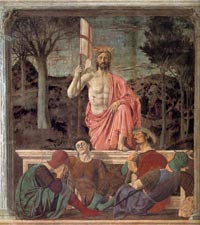
Resurrezione, Sansepolcro, Museo Civico
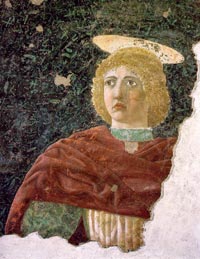 San Giuliano, Sansepolcro, Museo Civico (frammento) San Giuliano, Sansepolcro, Museo Civico (frammento)
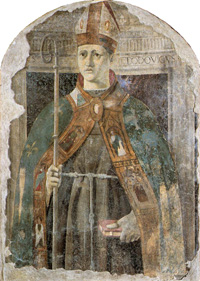
San Ludovico, Museo Civico
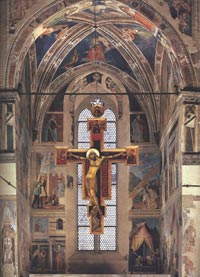 Cappella Maggiore di San Francesco ad Arezzo Cappella Maggiore di San Francesco ad Arezzo
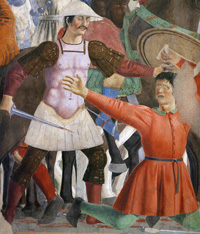
Piero della Francesca, Storie della Vera Croce: Battaglia di Eraclio e Cosroe, c. 1466, affresco, 329 x 747 cm, Ubicazione basilica di San Francesco, Arezzo
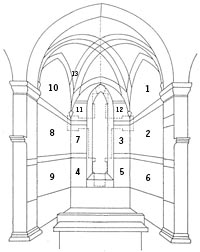
Narrative sequence
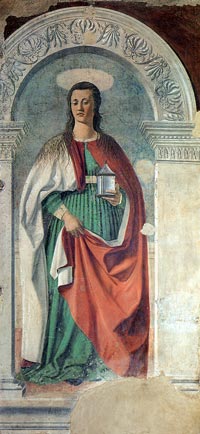 Santa Maria Maddalena, Duomo, Arezzo Santa Maria Maddalena, Duomo, Arezzo
|
![]()

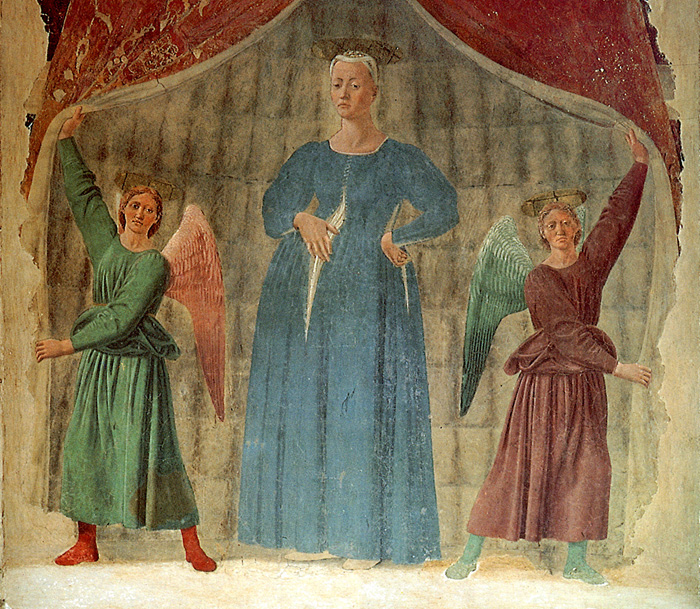
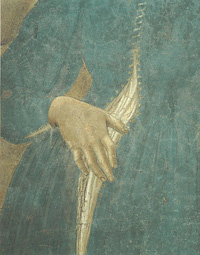
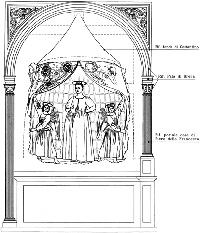
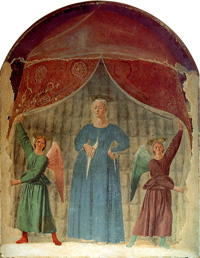 Madonna del parto, Museo Madonna del Parto a Monterchi
Madonna del parto, Museo Madonna del Parto a Monterchi 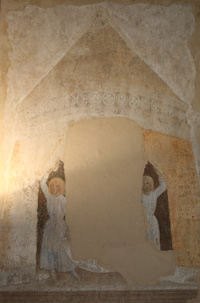
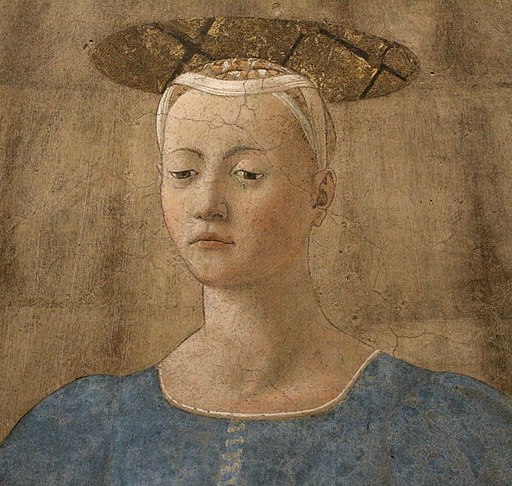

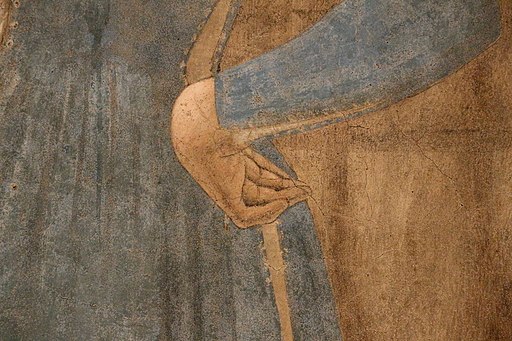
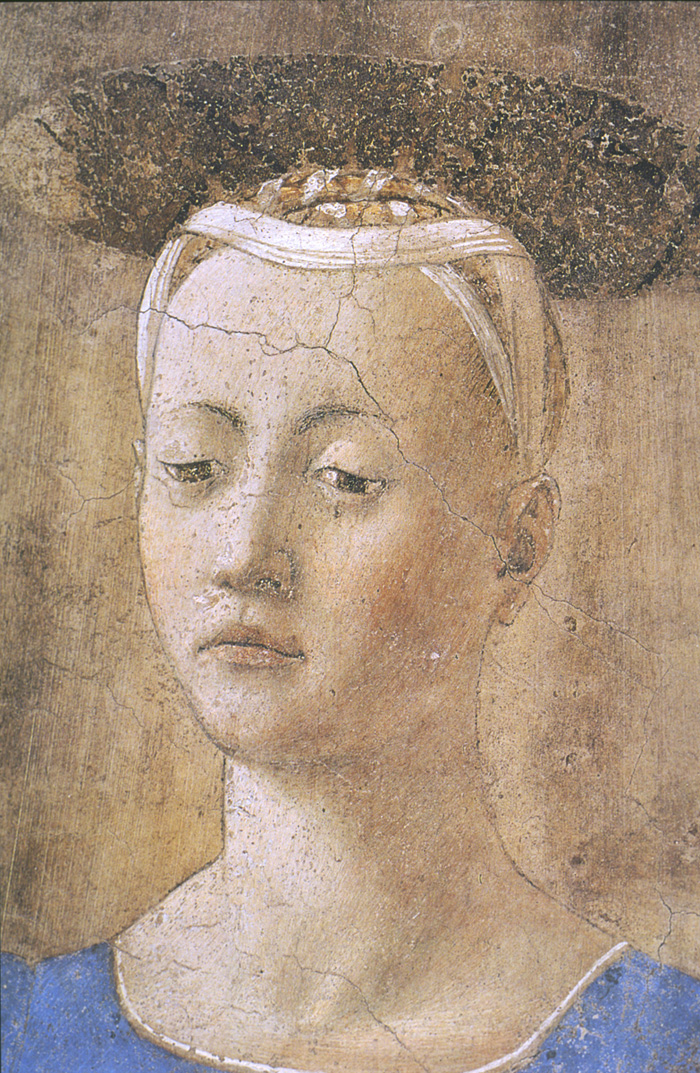
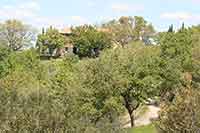


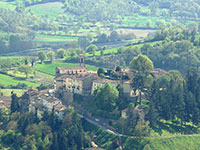
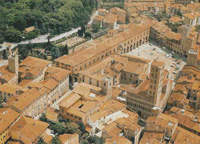
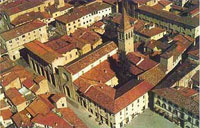






 Santa Maria Maddalena, Duomo, Arezzo
Santa Maria Maddalena, Duomo, Arezzo 